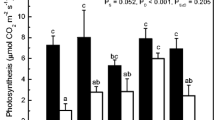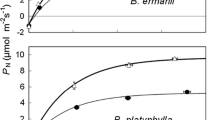Summary
Plant carbon/nutrient balance has been implicated as an important factor in plant defensive chemistry and palatability to herbivores. We tested this hypothesis by fertilizing juvenile growth form Alaska paper birch and green alder with N, P and N-plus-P in a balanced 2x2 factorial experiment. Additionally, we shaded unfertilized plants of both species. Fertilization with N and N-plus-P increased growth of Alaska paper birch, reduced the concentration of papyriferic acid in internodes and increased the palatability of birch twigs to snowshoe hares. Shading decreased birch growth, decreased the concentration of papyriferic acid in internodes and increased twig palatability. These results indicate that the defensive chemistry and palatability of winter-dormant juvenile Alaska paper birch are sensitive to soil fertility and shade. Conversely the defensive chemistry and palatability of green alder twigs to snowshoe hares were not significantly affected by soil fertility or shade. The greater sensitivity of Alaska paper birch defensive chemistry and palatability to snowshoe hares in comparison to green alder is in agreement with the hypothesis that early successional woody plants that are adapted to high resource availability are more plastic in their chemical responses to the physical environment than are species from less favorable environments.
Similar content being viewed by others
References
Behrend DF (1973) Wildlife management-forest fertilization relations. In: Forest fertilization. US For Serv Gen Tech Rep NE-3, pp 108–110
Bryant JP, Chapin FS III (1986) Browsing-woody plant interactions during boreal forest plant succession. In: Van Cleve K, Chapin FS III, Flanagan PW, Viereck LA, Dyrness CT (eds) Forest ecosystems in the Alaska taiga: A synthesis of structure and function. Springer, Berlin Heidelberg New York, pp 213–225
Bryant JP, Chapin FS III, Klein DR (1983a) Carbon/nutrient balance of boreal plants in relation to vertebrate herbivory. Oikos 40:357–368
Bryant JP, Chapin FS III, Clausen TP, Reichardt PB (1987) Effects of resource availability upon the woody plant-mammal interaction. In: Provenza F, Flinders J, McArthur D (eds) Proc 4th Ann Wildland Shrub Symp: Plant herbivore interactions (Snowbird, Utah 1985). Brigham Univ Press, Provo, Utah, pp 3–8
Bryant JP, Kuropat PJ (1980) Selection of winter forage by subarctic browsing vertebrates: the role of plant chemistry. Ann Rev Ecol Syst 11:261–285
Bryant JP, Wieland GD, Reichardt PB, Lewis VE, McCarthy MC (1983b) Pinosylvin methyl ether deters snowshoe hare feeding on green alder. Science 222:1023–1025
Chapin FS III (1980) The mineral nutrition of wild plants. Ann Rev Ecol Syst 11:233–260
Chapin FS III, Tryon PR, Van Cleve K (1983) Influence of phosphorus on growth and biomass distribution of Alaskan taiga tree seedlings. Can J For Res 13:1092–1098
Chapin FS III, Bryant JP, Fox JF (1985) Lack of induced chemical defense in juvenile Alaskan woody plants in response to simulated browsing. Oecologia (Berlin) 67:457–459
Chapin FS III, Van Cleve K, Tryon PR (1986) Relationship of ion absorption to growth rate in taiga trees. Oecologia (Berlin) 69:238–242
Clausen TP, Bryant JP, Reichardt PB (1986) Defense of winterdormant green alder against snowshoe hares. J Chem Ecol 12:2117–2131
Dugle JR (1966) A taxonomic study of western Canadian species in the genus Betula. Can J Bot 44:929–1007
Fox JF, Bryant JP (1984) Instability of the snowshoe hare and woody plant interaction. Oecologia (Berlin) 63:128–135
Gershenzon J (1984) Changes in the level of plant secondary metabolites under water and nutrient stress. In: Timmermann BN, Steelink C, Loewus FA (eds) Phytochemical adaptation to stress. Plenum, New York, pp 273–320
Grime JP (1977) Evidence for the existence of three primary strategies in plants and its relevance to ecological and evolutionary theory. Am Nat 111:1169–1194
Hanley TA, Cates RG, Van Horne B, McKendrick JD (1987) Forest stand age-related difference in apparent nutritional quality of forage for deer in southeastern Alaska. In: Provenza FD, Flinders GA, McArthur D (eds) Proc 4th Ann Wildland Shrub Symp (Snowbird, Utah). Brigham Young Univ Press, Proto, Utah, pp 9–17
Heiberg SO, White DP (1951) Potassium defficiency of reforested pine and spruce stands in northern New York. Soil Sci Soc Am Proc 15:309–376
Kozlowski TT (1971) Growth and development of trees, vol 1. Academic, New York, pp 462
Larsson S, Wiren A, Ericsson T, Lundgren L (1986) Effects of light and nutrient stress on defensive chemistry and susceptability to Galerucella lineola (Col, Chrysomelidae) in two Salix species. Oikos 47:205–210
Mihaliak CA, Lincoln DE (1985) Growth pattern and carbon allocation to volatile leaf terpenes under nitrogen-limiting conditions in Heterotheca subaxillaris (Asteraceae). Oecologia (Berlin) 66:423–426
Mooney HA (1972) The carbon balance of plants. Ann Rev Ecol Syst 3:315–346
Reichardt PB, Bryant JP, Clausen TP, Wieland GD (1984) Defense of winter-dormant Alaska paper birch against snowshoe hares. Oecologia (Berlin) 65:58–59
Robbins CT, Hanley TA, Hagerman AE, Hjeljord O, Baker DL, Schwartz CC, Mautz WW (1987) Role of tannins in defending plants against ruminants: Reduction in protein availability. Ecology 68:98–107
Rohleder RJ (1985) Behavioral interactions and food preferences of snowshoe hares in winter. Thesis, Univ Alaska, Fairbanks, pp 91
Rousi M (1983) Susceptibility of pine to mammalian herbivores in northern Finland. Silva Fennica 17:301–312
Sokal RR, Rohlf FJ (1969) Biometry. Freeman, San Francisco, pp 776
Sullivan TP, Sullivan DS (1982) Influence of fertilization on feeding attacks to lodgepole pine by snowshoe hares and red squirrels. For Chronicle 58:263–266
Viereck LA, Little EJ Jr (1972) Alaska trees and shrubs. US Dep Agric Handb 410, pp 265
Waring RH, McDonald AJS, Larsson S, Ericsson T, Wiren A, Arwidsson E, Ericsson A, Lohammar T (1985) Differences in chemical composition of plants grown at constant relative growth rates with stable mineral nutrition. Oecologia (Berlin) 65:157–160
Waterman PG, Ross JAM, McKey DB (1984) Factors affecting levels of some phenolic compounds, digestibility, and nitrogen content of the mature leaves of Barteria fistulosa (Passifloraceae). J Chem Ecol 10:387–401
Author information
Authors and Affiliations
Rights and permissions
About this article
Cite this article
Bryant, J.P., Chapin, F.S., Reichardt, P.B. et al. Response of winter chemical defense in Alaska paper birch and green alder to manipulation of plant carbon/nutrient balance. Oecologia 72, 510–514 (1987). https://doi.org/10.1007/BF00378975
Received:
Issue Date:
DOI: https://doi.org/10.1007/BF00378975




